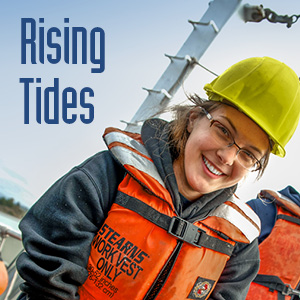Breadcrumb
Department of Oceanography
Among the few undergraduate programs of its kind in California, a Bachelor of Science in Oceanography at Cal Poly Humboldt provides a firm foundation in the study of the physical, chemical, and biological aspects of the ocean through a rigorous combination of academics and practical oceangoing experience on the North Coast.
The ocean covers 70 percent of the planet and is crucial to our survival. With ecological sustainability in mind, our Oceanography undergraduate program is one of the few in California.
Program Overview
People often ask: "What is the difference between Oceanography and Marine Biology?" While both disciplines include study of ocean organisms, Oceanography examines the entire range of ocean processes, including the physics, chemistry, and geology, as well as the biology. Oceanography requires understanding a broad range of scientific fields and techniques to engage with the ocean as a whole system.
The B.S. Oceanography program is designed specifically for students interested in pursuing professional, research or academic careers, and/or advanced degrees in ocean sciences. Once you master the basics, you'll take courses with an oceanic focus, such as biological oceanography, chemical oceanography, geological oceanography and physical oceanography.
At the same time you’ll have a chance to apply what you’ve learned in the classroom. Practice cutting-edge research techniques aboard our oceangoing vessel, the Coral Sea and the nearby Telonicher Marine Laboratory. And gain practical experience from professional scientists through paid research opportunities at partnerships with large science organizations. We’re a small department, too, which means class sizes are small. You’ll have plenty of chances to get to know faculty and receive personal attention from professors.
Program Options
Bachelor of Science in Oceanography
Our major provides students a broad science background, an understanding of fundamental concepts unique to Oceanography, and an appreciation for how concepts from various closely allied science fields are interrelated and applied to the solution of oceanographic problems. The goal of the program is to develop interdisciplinary science knowledge, which is essential to the study and understanding of the oceans.
Sub-disciplines
Students who major in Oceanography can also tailor the program to a range of sub-disciplines that have an oceanic focus, making it easy to earn a minor in other disciplines such as Biology, Chemistry, and Geology.
- Biological Oceanography: the study of marine ecosystems and how they function.
- Chemical Oceanography: the study of how chemicals move through the marine environment.
- Geological Oceanography: the study plate tectonics, classification of major bathymetric features, and the distribution, transport and deposition of recent sediments in the marine environment.
- Physical Oceanography: the study of the physical conditions and physical processes within the ocean such as waves, currents, eddies, gyres and tides.
Minor
Location
Humboldt is just minutes away from the Pacific Ocean, giving you easy access not only to the largest and deepest ocean on Earth, but also to a unique stretch of coastal California known as the North Coast, which is home to some of California’s most wild and pristine coastline.
For years, Humboldt has been the only major institution with a coastal presence between Bodega Bay, California and Coos Bay, Oregon. The North Coast is among the least understood regions of the West Coast, providing students unique opportunities for research with faculty, internships, and volunteer work.

Practical Experience
The Oceanography program is based heavily in field-based experiences that will hone your critical thinking skills and reinforce what you're learning in the classroom.
Your immersion into Oceanography begins right away. As a freshman, you’ll automatically be part of the Rising Tides learning community. It’s a yearlong program designed to teach you marine science by letting you be a marine scientist. And you’ll build connections with students who are as passionate about the ocean as you.
We’re a small, close-knit department that focuses on more than academics. As early as your sophomore year, you’ll engage in internships and paid research opportunities. For instance, undergraduate students have been hired to deploy balloons that measure gas concentrations in the atmosphere -- data they used for further research and their thesis.

Curriculum
Our rigorous, broad, and versatile program can be tailored to a range of subdisciplines in science, such as Biology, Chemistry, Geology and Physics, even SCUBA. Humboldt’s B.S. Oceanography program is designed specifically for students interested in pursuing professional, research or academic careers and/or advanced degrees in ocean sciences.
Once you master the basics, you'll take courses with an oceanic focus, such as biological oceanography, chemical oceanography, geological oceanography and physical oceanography. You'll learn and practice the techniques needed to conduct research at sea and in the laboratory. You'll also gain the critical writing, presentation, and interpersonal skills necessary for your success in the scientific and technical world.
Your experience at Humboldt culminates with a scientific research project under the supervision and guidance of faculty. The end result? You graduate with more than a degree — you graduate with skills and experience.


Freshmen Learning Community
Living minutes away from some of the most wild, pristine, and vibrant coastline in California, you can venture onto the open ocean to explore its depths aboard a 90-foot research vessel, or wade into rocky tidepools to study sea stars. Real-world experiences like these help you not only learn marine science, but also puts you on a path to becoming a marine scientist. This program is for Biology (Marine Biology concentration) and Oceanography majors.
Featured Alumni
Career Options
With a strong foundation in science and oceanic studies, you will have the knowledge and skills to tackle some of the most pressing issues that affect the health of our oceans and in turn, the health of our planet. Those issues include rising seawater, pollutants, the impact of human activity on marine ecosystems, and seismic activity.
Our graduates are also well-prepared for the next step in their lives. Some pursue their masters or Ph.D. programs at some of the world’s best graduate schools. Others pursue a variety of private sector and governmental careers. In fact, over 80 percent of our graduates get jobs related to their Oceanography degree at research companies, science centers, public and environmental health departments, and government agencies.
Here are a few examples of possible career fields.
- Marine Biologist
- Biological Oceanographer
- Water Pollution Chemist
- Chemical Oceanographer
- Tsunami Modeler
- Physical Oceanographer
- Geologist
- Geologist Oceanographer
- Coastal/Ocean Engineer
- Sea-going Technician
- Marine Research Assistant
- Scientific Diver
Achievements
Find out what our students, faculty, and staff are being recognized for.
Jeffrey Abell, Tamara Barriquand, Christine Cass, Malcolm Edwards-Silva, Kenneth Mathe, Marcos Moreno, Carla Villanueva, Ethan Wadsworth
Oceanography
Oceanography faculty Jeffrey Abell, Tamara Barriquand, and Christine Cass presented their research at the international Ocean Sciences Meeting (New Orleans, LA) in February. This ~6,000 person conference brings together marine scientists from across disciplines. Undergraduate students Malcolm Edwards-Silva, Marcos Moreno, Carla Villanueva, Ethan Wadsworth, and Kenneth Mathe (Fall '23) also attended to present a poster on their capstone research project.
Kezia Ramussen
Oceanography
Poster presented "Analyzing Taxonomic Diversity of the Human Gut Microbiome Using R"
Jacob Partida
Oceanography
Through his work with research scientists at Woods Hole Oceanographic Institute Jacob Partida recently published his first co-authored article in a scientific journal. The article “The Changing Nature of Shelf-Break Exchange Revealed by the OOI Pioneer Array” can be found in the most recent volume (31) of Oceanography.









